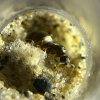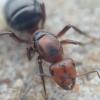Pretty sure this is fusca group, but I would rather have people more experienced than me come to a conclusion.
I know its probably quite hard to nail a species down, but I'm guessing this is subsericea.
Approximately 10mm.


Best Answer Mettcollsuss , August 1 2024 - 11:41 AM
Formica fusca group, almost certainly subsericea, however there are some rarer species that cannot be definitively ruled out. We would need to see the relative density of the pubescence on the third and fourth tergites and/or the presence or absence of large punctures on the malar area in order to distinguish it from F. argentea, and the relative density of the gaster pubescence and pilosity to separate from species like subaenescens, podzolica, or glacialis.
Go to the full post
Wow she looks aggressive in that first photo! And pretty fat with food! Formica subsericea is my guess.
Currently raising:
Myrmica Rubra (1 queen + ~5 workers)
Lasius Niger (single queen + ~90+ workers)
Lasius Neoniger (two single queen + brood)
Formica spp. (Queen [likely parasitic, needs brood])
Also keeping a friend's tetramorium immigrans for the foreseeable future. Thanks CoffeBlock!
Keeping:
3x - S. molesta (colonies and single queen) 1x - C. nearcticus (founding but no eggs) ![]() New!
New!
1x - C. chromaiodes (colony) 1x - C. subbarbatus (founding)
1x - F. subsericea (founding) 1x - T. sessile (mega colony)
3x - P. imparis (colonies)
2x - L. neoniger (founding)
Check out my C. nearcticus journal here: https://www.formicul...cticus-journal/
Check out my C. chromaiodes journal here: https://www.formicul...aiodes-journal/
If it’s any help in direct sunlight the gaster is highly silver in color.It could also be F. neogagates but I don't see any silver band on the gaster from these pics indicating F. subsericea. Although it still could be F. subsericea.
Then yeah that's definitely F. subsericea (as from what I know, F. neogagates is a completely solid color with no silver effect to the gaster. The setae on their gaster comparatively is the same exact as F. subsericea at least to the naked eye).If it’s any help in direct sunlight the gaster is highly silver in color.It could also be F. neogagates but I don't see any silver band on the gaster from these pics indicating F. subsericea. Although it still could be F. subsericea.
Keeping:
3x - S. molesta (colonies and single queen) 1x - C. nearcticus (founding but no eggs) ![]() New!
New!
1x - C. chromaiodes (colony) 1x - C. subbarbatus (founding)
1x - F. subsericea (founding) 1x - T. sessile (mega colony)
3x - P. imparis (colonies)
2x - L. neoniger (founding)
Check out my C. nearcticus journal here: https://www.formicul...cticus-journal/
Check out my C. chromaiodes journal here: https://www.formicul...aiodes-journal/
I did find the queen in a field woodland border, with a marsh nearby. I don’t know if that’s any indication of species however.Then yeah that's definitely F. subsericea (as from what I know, F. neogagates is a completely solid color with no silver effect to the gaster. The setae on their gaster comparatively is the same exact as F. subsericea at leastIf it’s any help in direct sunlight the gaster is highly silver in color.
It could also be F. neogagates but I don't see any silver band on the gaster from these pics indicating F. subsericea. Although it still could be F. subsericea.
to the naked eye).
Keeping:
3x - S. molesta (colonies and single queen) 1x - C. nearcticus (founding but no eggs) ![]() New!
New!
1x - C. chromaiodes (colony) 1x - C. subbarbatus (founding)
1x - F. subsericea (founding) 1x - T. sessile (mega colony)
3x - P. imparis (colonies)
2x - L. neoniger (founding)
Check out my C. nearcticus journal here: https://www.formicul...cticus-journal/
Check out my C. chromaiodes journal here: https://www.formicul...aiodes-journal/
Currently keeping:
1x Solenopsis molesta
1x Formica subsericea (polygynous) has WORKERS!!! ![]() RAHHHHHHHHHHHHHHHHHHHHHHHHHHHHHHHHHHH!!!!!
RAHHHHHHHHHHHHHHHHHHHHHHHHHHHHHHHHHHH!!!!!
2x Lasius niger (one is polygynous and the other is monogynous)
Formica fusca group, almost certainly subsericea, however there are some rarer species that cannot be definitively ruled out. We would need to see the relative density of the pubescence on the third and fourth tergites and/or the presence or absence of large punctures on the malar area in order to distinguish it from F. argentea, and the relative density of the gaster pubescence and pilosity to separate from species like subaenescens, podzolica, or glacialis.
Formica fusca group, almost certainly subsericea, however there are some rarer species that cannot be definitively ruled out. We would need to see the relative density of the pubescence on the third and fourth tergites and/or the presence or absence of large punctures on the malar area in order to distinguish it from F. argentea, and the relative density of the gaster pubescence and pilosity to separate from species like subaenescens, podzolica, or glacialis.
Even though it doesn't matter, I probably will take pictures of those regions you listed and post it here. If you do reread this thread and find the pictures then it would be cool to know exact species if the pictures are adequate.
0 members, 1 guests, 0 anonymous users